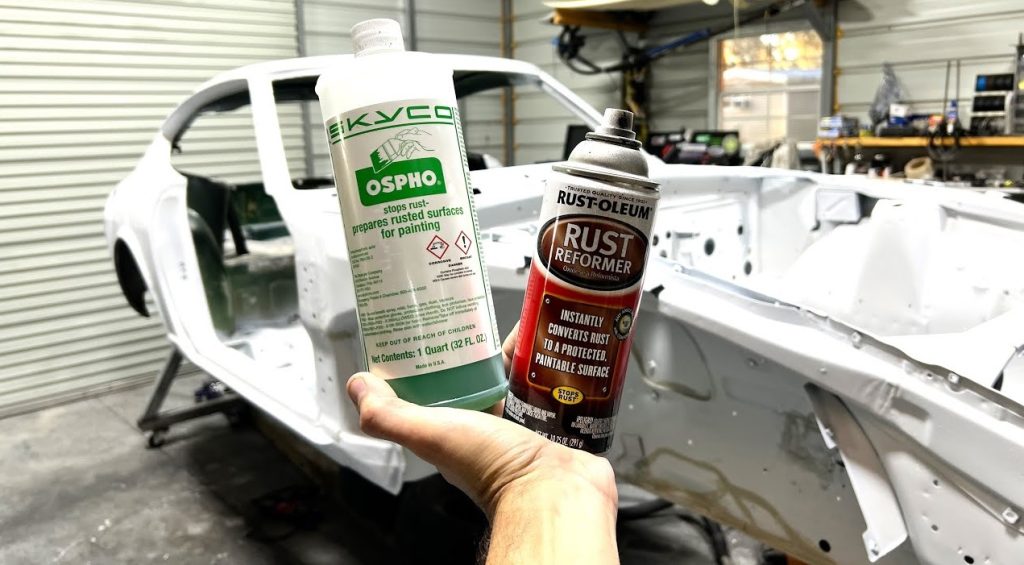Painting over rusted surfaces can be a challenging yet rewarding DIY project. Among the various products available, Ospho and Rustoleum stand out for their effectiveness in rust treatment and painting, respectively. In this comprehensive guide, we will delve into the intricacies of painting with Rustoleum over Ospho, providing you with detailed insights and step-by-step instructions to ensure your project’s success.
Understanding the Basics
1. Ospho and Rustoleum Overview: Before delving into the process, let’s understand the roles of Ospho and Rustoleum. Ospho acts as a rust converter, transforming rust into a more paintable surface. Rustoleum, on the other hand, is renowned for its durable and versatile paint formulations.
2. Rust Treatment with Ospho: Proper surface preparation is crucial. Begin by cleaning the surface thoroughly, removing loose rust and debris. Once clean, apply Ospho according to the manufacturer’s instructions. This solution will convert rust into a stable substrate, providing a suitable canvas for the painting process.
Choosing the Right Rustoleum Product
3. Rustoleum Primer: A critical step is applying a Rustoleum primer designed specifically for metal surfaces. This not only enhances adhesion but also creates a barrier against future rusting.
4. Rustoleum Paint Selection: The success of your project relies on choosing the right Rustoleum paint. Consider factors such as the color you desire, the finish that suits your project, and whether the painted surface will be exposed to harsh weather conditions.
Step-by-Step Painting Process
5. Primer Application: After the Ospho treatment, apply the Rustoleum primer evenly over the surface. Ensure it dries completely before progressing to the next steps.
6. Stirring and Mixing: Achieving the right consistency is crucial. Stir and mix the Rustoleum paint thoroughly according to the manufacturer’s instructions. Consistency ensures a smooth application and an even finish.
7. Painting Technique: Use a high-quality brush or roller to apply the Rustoleum paint. Adopt even strokes to achieve a professional-looking finish. Take your time and pay attention to detail during this phase.
8. Drying Time: Patience is key. Allow each coat, including the primer, to dry completely before applying the next one. Follow the recommended drying times on the Rustoleum paint can for optimal results.
Tips and Tricks
9. Adequate Ventilation: Ensure proper ventilation in the painting area to promote drying and prevent fumes from accumulating. This is not only essential for the paint but also for your well-being.
10. Multiple Thin Coats: Instead of applying one thick coat, opt for multiple thin coats. This approach not only ensures a more even finish but also enhances the durability of the painted surface.
11. Surface Preparation: The success of your project hinges on proper surface preparation. Any shortcuts in cleaning, sanding, and Ospho applications can compromise the final result.
Common Concerns Addressed
12. Compatibility: While Rustoleum is generally compatible with Ospho-treated surfaces, always check product labels for any specific restrictions or recommendations. Following the guidelines meticulously is crucial for a successful outcome. (See Also: Can You Clear Coat Single Stage Paint? A Comprehensive Guide)
13. Topcoating Considerations: For added protection, consider applying a clear Rustoleum topcoat. This extra layer acts as a shield, safeguarding the painted surface from various environmental elements.
Troubleshooting
14. Adhesion Issues: If you encounter problems with adhesion, revisit the surface preparation steps. Ensure that the Ospho treatment and primer application are done meticulously. Any lapses in this stage can lead to adhesion problems.
15. Rust Resurgence: Periodically inspect the painted surface for any signs of rust resurgence. Address any issues promptly with spot treatments and additional layers of Rustoleum paint.
Final Touches and Maintenance
16. Inspection and Maintenance: Once the paint has dried completely, inspect the finished project. Regular maintenance, such as cleaning and touch-ups, will prolong the life of the painted surface. Keep an eye out for any areas that may require attention over time.
Additional Considerations
17. Temperature and Humidity: Take into account the ambient temperature and humidity levels during the painting process. These factors can influence drying times and the overall quality of the finish.
18. Exterior vs. Interior Projects: Consider the specific needs of your project, whether it’s an outdoor or indoor application. Different Rustoleum products may be more suitable for varying environments.
Expert Tips for Painting Rustoleum Over Ospho-Treated Surfaces
When it comes to painting over Ospho-treated surfaces with Rustoleum, incorporating expert tips can elevate your project’s success. These insights, born from experience and industry knowledge, ensure that your painted surfaces not only look stunning but also stand the test of time. Let’s delve into these expert tips to enhance your painting journey.
1. Thorough Surface Inspection:
Before diving into the painting process, meticulously inspect the Ospho-treated surface. Address any residual rust, imperfections, or irregularities that might affect the paint’s adhesion.
2. Use High-Quality Tools:
Invest in high-quality brushes or rollers for applying Rustoleum. Quality tools contribute to a smoother application, resulting in a more professional finish.
3. Follow Recommended Drying Times:
Resist the temptation to rush the drying process. Follow the recommended drying times for both the Ospho treatment and each coat of Rustoleum paint. Patience ensures optimal adhesion and durability.
4. Apply Thin and Even Coats:
Opt for multiple thin coats rather than a single thick layer. This technique not only enhances the paint’s durability but also prevents unsightly drips and uneven finishes. (See Also: Can You Use Rustoleum Paint Over Powder Coat? Tips and Tricks)
5. Consider Temperature and Humidity:
Take note of the ambient temperature and humidity levels during the painting process. Ideal conditions contribute to a smoother application and better overall results.
6. Spot Treat Any Rust Resurgence Promptly:
Even with Ospho treatment, occasional rust spots may appear over time. Spot treat these areas promptly with a touch of Ospho and an additional layer of Rustoleum for lasting protection.
7. Topcoat for Extra Protection:
For surfaces exposed to harsh elements, consider adding a clear Rustoleum topcoat. This additional layer provides extra protection against UV rays, moisture, and other environmental factors.
8. Regular Maintenance is Key:
Don’t overlook the importance of regular maintenance. Periodically inspect painted surfaces, address any issues promptly, and perform touch-ups as needed to extend the lifespan of your project.
9. Customize for Specific Environments:
Different Rustoleum products may be better suited for specific environments. Tailor your paint selection to whether the painted surface will be exposed to the outdoors or remain indoors.
10. Protective Gear is Essential:
Ensure your safety during the painting process by using appropriate protective gear, including gloves, goggles, and a mask. It’s a small investment for your well-being.
By incorporating these expert tips into your painting project, you not only enhance the aesthetic appeal of your surfaces but also ensure the longevity of your work. Paint with confidence, armed with the knowledge that comes from seasoned expertise.
Frequently Asked Questions About Painting with Rustoleum Over Ospho
Embarking on a project to paint Rustoleum over Ospho-treated surfaces may raise various questions. To provide clarity and guidance, we’ve compiled a list of frequently asked questions along with comprehensive answers. Whether you’re a seasoned DIY enthusiast or a beginner, these FAQs address common queries to ensure a smooth painting experience.
1. Can I Paint Rustoleum Over Ospho Without Surface Preparation?
No, surface preparation is crucial. Cleaning the surface, removing loose rust, and applying Ospho are essential steps to ensure proper adhesion of the Rustoleum paint.
2. How Long Should I Wait After Applying Ospho Before Painting with Rustoleum?
Follow the manufacturer’s guidelines, but generally, waiting 24 hours after Ospho application allows for optimal rust conversion before applying Rustoleum.
3. Is Rustoleum Compatible with All Types of Ospho?
While Rustoleum is generally compatible with most Ospho products, it’s advisable to check the product labels for specific recommendations or restrictions.
4. Do I Need a Rustoleum Primer Before Applying the Paint?
Yes, using a Rustoleum primer designed for metal surfaces is crucial. It enhances adhesion and provides an additional layer of protection against rust. (See Also: Can You Spray Raptor Liner Over Chrome? Expert Tips and Guidelines)
5. Can I Apply Rustoleum Directly Over Ospho Without a Primer?
While Ospho aids in rust conversion, using a Rustoleum primer is recommended for optimal results. It ensures better adhesion and a more durable finish.
6. What Should I Do If I Encounter Adhesion Issues After Painting?
Revisit the surface preparation steps. Ensure that the Ospho treatment and primer application are done meticulously. Sanding and cleaning may be necessary.
7. Should I Apply a Clear Topcoat Over Rustoleum for Extra Protection?
For surfaces exposed to harsh elements, applying a clear Rustoleum topcoat is a wise choice. It adds an extra layer of protection against UV rays and environmental factors.
8. Can I Use Rustoleum Over Ospho for Outdoor Projects?
Yes, Rustoleum is suitable for outdoor projects. Choose a Rustoleum paint formulated for exterior use to ensure durability in various weather conditions.
9. How Can I Address Rust Resurgence After Painting?
Spot treat any rust resurgence promptly by applying a touch of Ospho to affected areas. Follow up with an additional layer of Rustoleum paint for protection.
10. Is It Necessary to Use Protective Gear While Painting with Rustoleum Over Ospho?
Yes, it’s essential to prioritize safety. Wear protective gear such as gloves, goggles, and a mask to safeguard yourself during the painting process.
These FAQs cover common concerns and queries related to painting with Rustoleum over Ospho. Whether you’re troubleshooting issues or seeking guidance on specific steps, refer to these answers for a successful painting experience.
Conclusion
In conclusion, painting with Rustoleum over Ospho is a practical and effective method to rejuvenate metal surfaces. By following this comprehensive guide, you can embark on this DIY journey with confidence, transforming rusted items into beautifully painted assets. Enjoy the process, savor the satisfaction of a job well done, and relish the longevity of your revitalized surfaces!



